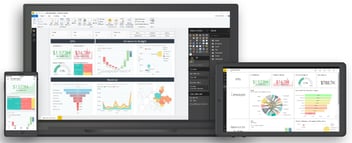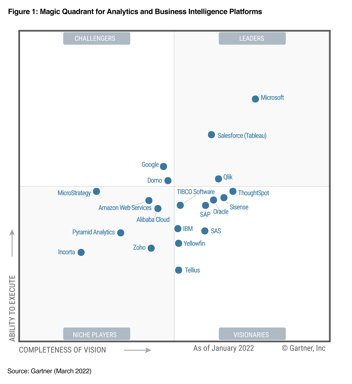We introduce the latest Microsoft updates of 2020-2021! Don't miss the new impacting features of Microsoft tools.
The new year has come with plenty of new features that will satisfy data enthusiasts. Let's review the latest and most important news and updates from Microsoft!

En este artículo encontrarás...
- Microsoft News For 2021
- Azure Synapse: General Availability
- Azure PureView: One Step Closer To Data Governance
- Power BI: Composite Models and Premium Per User (PPU) in Power BI
- New AI Functions in PowerApps
- Intelligent Search in PowerApps
- New Sharing Options From Microsoft Dataverse To Teams
- Enhanced Connectivity Between Dataverse And Power BI Direct Query
If you are passionate about data, you will probably know that Microsoft is constantly renewing and improving all its data processing, analysis and management tools. So often, that it is quite difficult to keep up with all the updates. But don't worry, at Bismart, as a partner Power BI company, we try to keep up with them to inform you of the most relevant updates that you should know about.
Regular readers of this blog will know that every time Microsoft launches a new product or makes a relevant change in one of its platforms, we report on it. In our last posts we already talked about the latest developments in Power Platform, Zebra BI and Power BI. If you don't know them yet, we recommend that you take a look at them before discovering...
Microsoft News For 2021
-
Azure Synapse: General Availability
2020 began with one of the most notable and highly anticipated announcements of the year: the launch of Azure Synapse, an evolution of Azure SQL Data Warehouse. At the time of its launch we already explained the reasons that make Azure Synapse the ideal data warehousing and analytics platform for large corporations. If you would like to know it in more detail, you can read our previous post: "What is Azure Synapse and How Is It Different From Azure Databricks?"
Similar to how it started, 2020 ended with exciting news for Synapse followers: the end of the availability 'on demand' (in preview) of the Synapse Analytics integrated environment, replaced now by the general availability, through which finally everyone can have access to the new SQL Serverless engine.
- Azure PureView: One Step Closer To Data Governance
Another major highlight of 2020 was the launch of Azure Pureview, a new service exclusively dedicated to data governance. This service enables the management and control of data in on-premises, cloud and SaaS environments.
The great advantage of this tool is that it greatly facilitates data governance processes through capabilities such as the creation of holistic maps of the data landscape, automated data discovery or classification of confidential data.
Azure PureView has several components. The data discovery, classification and mapping function automatically locates all company data, both on-premises and in the cloud, and evaluates its properties and veracity.
Through a data catalog, users can search for external data without fearing that the data is untrusted or from unreliable sources, as PureView has enabled a trusted data detection system that allows them to see where the data is coming from.
Azure PureView is, in short, a unique service with which companies can know exactly what data they have, manage it easily and securely, ensure that their data are validated and are of quality (data quality) and that they are ready to be used in areas of business intelligence. In addition, Pureview ensures data security and compliance with applicable regulations regarding data use and protection.
- Power BI: Composite Models V2 and Premium Per User (PPU) in Power BI
In December 2020, Microsoft announced an update that for sure, was big news for all Power BI regulars: the V2 composite models that allow you to add more than one data connection —from Direct Query or import— to Power BI Desktop, Power BI Datasets and Azure Analysis Services.
Previously, when using Direct Query in a report, it was not possible to import any other data connections. Now, instead, reports can be supplemented with two or more data connections from different sources. In addition, composite models support establishing many-to-many relationships between tables and establishing which visual objects initiate queries from back-end data sources.
The new Premium Per User (PPU) licenses are now available, although pricing has not yet been announced. These new licenses have almost all the functionality of the current Power BI Premium (by capacity) with the advantages of Power BI Pro per-user licensing.
- New AI Functions In PowerApps:
A few days before the end of the year, Microsoft announced the availability of new artificial intelligence features in PowerApps.
PowerApps AI Builder is enriched with two new features: prediction of multiple outcomes and prediction of a numeric field. These capabilities enhance the AI Builder prediction model, which now has capabilities to solve more complex problems and make more advanced forecasts.
The old prediction model was only able to predict binary outcomes such as whether a shipment would arrive on time or not. Now, the model offers more than 3 possibilities, being able to predict whether the shipment will arrive early, on schedule or late.
In addition, AI Builder is now also able to make numerical predictions such as the number of hours it will take to develop a project or the number of days it will take to close a deal with a customer.
- Intelligent Search In PowerApps
Microsoft is enhancing the relevance search capabilities of PowerApps with machine learning capabilities. The idea is that the PowerApps search engine gets smarter as it is used and collects data. Thus, relevance search results will improve over time, leading to more accurate answers in relation to the data being searched.
Some of the new search capabilities are:
- Spell checking: If a query contains typos or misspellings, the relevance search will find matches with correctly spelled words.
- Recognition of abbreviations and acronyms: The search will be able to recognize the most common acronyms and abbreviations.
- Enhanced understanding: The search engine will apply common knowledge, recognition of frequently used synonyms and understanding of language to enrich queries.
- New Sharing Options from Microsoft Dataverse to Teams
Previously, applications built on Microsoft Dataverse (formerly called Microsoft Common Data Service) for Teams could only be replicated by members of a team. This was sufficient in the case of applications targeted at specific users, but made it difficult to create and disseminate applications intended to be operational on a global scale within an organization.
In response to this issue, Microsoft has enabled wide distribution applications for Teams in Dataverse. Now, members of a company will be able to share applications created within a particular Teams team with the rest of the company.
This allows more control over the management of end-user access to applications. Companies will be able to delimit which applications users can access and share apps beyond their development environment.
- Enhanced Connectivity Between Dataverse and Power BI Direct Query:
At Bismart, as a Microsoft Power BI partner, we pay special attention to the improvements that this tool is including. The connectivity between Power BI and Dataverse has been improved thanks to a new tabular data flow (TDS) and a new Dataverse connector for Power BI. This gives Power BI users more options for connecting to Dataverse environments —including Dataverse for Teams— and increased relationship discovery capabilities in the Power BI data model.
The new connector supports Direct Query providing real-time data and support for the Dataverse security model.
These are the most important Microsoft updates of the last months. As new updates are released, as always, we will keep you informed.
If you want to keep up to date with the latest Microsoft updates, subscribe to our blog and don't miss any details!



